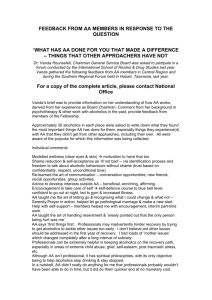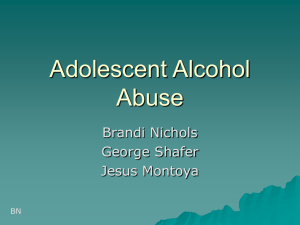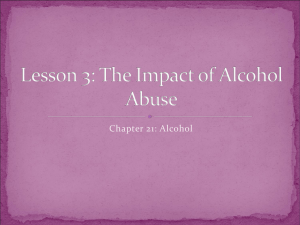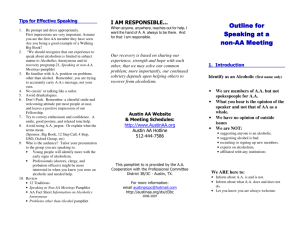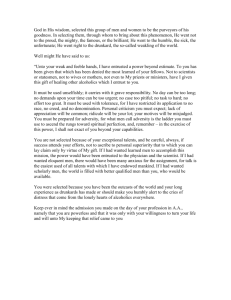PowerPoint File of CPC Presentation
advertisement
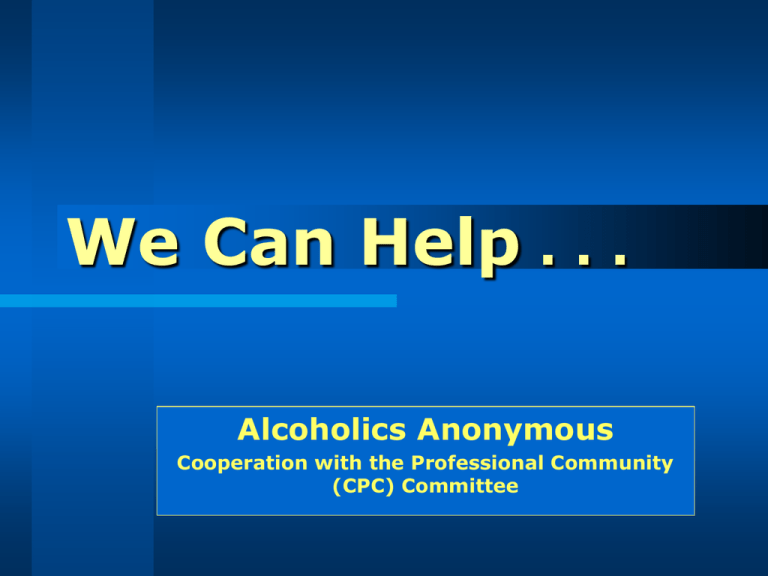
We Can Help . . . Alcoholics Anonymous Cooperation with the Professional Community (CPC) Committee How Did A.A. Start? What is A.A.? How Big is A.A.? What Does A.A. Do? What A.A. Does Not Do The 12 Traditions of A.A. How Did A.A. Start? The Birth of A.A. and its growth in the U.S. & Canada had its beginnings in 1935 at Akron, Ohio, as the outcome of a meeting between Bill W., a New York stock analyst, and Dr. Bob S., an Akron surgeon. Both had been hopeless alcoholics. Prior to that time, Bill and Dr. Bob had each been in contact with the Oxford Group, a mostly non-alcoholic fellowship that emphasized universal spiritual values in daily living. In that period, the Oxford Groups in America were headed by the noted Episcopal clergyman, Dr. Samuel Shoemaker. Under this spiritual influence, and with the help of an oldtime friend, Ebby T., Bill had gotten sober and had then maintained his recovery by working with other alcoholics, though none of these had actually recovered. Meanwhile, Dr. Bob’s Oxford Group membership at Akron had not helped him enough to achieve sobriety. How Did A.A. Start? When Dr. Bob and Bill finally met, through the assistance of a clergyman, the effect on the doctor was immediate. This time, he found himself face to face with a fellow sufferer who had made good. Bill hammered home that alcoholism was a malady of mind, emotions and body. He had learned this all-important fact from Dr. William D. Silkworth of Towns Hospital in New York, where Bill had often been a patient. Though a physician himself, Dr. Bob had not known alcoholism to be a disease. Responding to Bill’s convincing ideas, he soon got sober, never to drink again. The founding spark of A.A. had been struck. Both men immediately set to work with alcoholics at Akron’s City Hospital, where one patient quickly achieved complete sobriety. How Did A.A. Start? Though the name Alcoholics Anonymous had yet to be coined, these three men actually made up the nucleus of the first A.A. group. In the fall of 1935, a second group of alcoholics slowly took shape in New York. A third appeared at Cleveland in 1939. It had taken more than four years to produce 100 sober alcoholics in the three founding groups. Early in 1939, the Fellowship published its basic textbook, Alcoholics Anonymous. The text, written by Bill, explained A.A.’s philosophy and methods, the core of which was the now well-known Twelve Steps of recovery. The book was also reinforced by case histories of some thirty recovered members. From this point, the development of Alcoholics Anonymous was rapid. How Did A.A. Start? What is A.A.? How Big is A.A.? What Does A.A. Do? What A.A. Does Not Do The 12 Traditions of A.A. What is A.A.? Alcoholics Anonymous® is a fellowship of men and women… A.A. members need always maintain personal anonymity at the level of press, radio, film, TV, etc. In all other cases, we can say we’re members but should never break another member’s anonymity. A.A. is not a religious group, cult, business, etc. Nor is it a social club or dating service. A.A. membership is open to men and woman of all ages, races, creeds and colors assuming they meet our one requirement. … who share their experience, strength and hope with each other … A.A. members don’t give each other advice nor require any type of conformance. A.A. provides no professional or social services. We simply share what we’ve done and the results we have gotten. What is A.A.? …that they may solve their common problem and help others to recover from alcoholism. Alcoholism is our focus. Helping others helps us. We recover. However, we are never cured. The only requirement for membership is a desire to stop drinking. Anyone with a drinking problem who has a desire to stop may become an A.A. member. A.A. members do not diagnose each other. Each member must declare himself or herself an alcoholic. Individuals who have no history of problem drinking are not eligible for A.A. membership. There are no dues or fees for A.A. membership; It costs nothing to join A.A. or to remain a member of Alcoholics Anonymous. What is A.A.? …we are self-supporting through our own contributions. A.A. accepts money from no one but its members. There is a $2,000 limit per member per year. A.A. is not allied with any sect, denomination, politics, organization or institution; A.A. has no religious, political or business affiliations. We are not linked to any other 12-Step programs. A.A. has no connection with any medical or treatment centers. does not wish to engage in any controversy; A.A. does not support one medical or psychological viewpoint over another as it relates to alcoholism. neither endorses nor opposes any causes. A.A. is not a temperance movement. A.A. is not opposed to or in favor of drinking alcohol. What is A.A.? Our primary purpose is to stay sober and help other alcoholics to achieve sobriety. A.A. members have no other agendas or objectives but to maintain their sobriety and pass along what was freely given to them. Rarely have we seen a person fail who has thoroughly followed our path. People recover if they work the 12 Steps. The A.A. Preamble Alcoholics Anonymous is a fellowship of men and women who share their experience, strength and hope with each other that they may solve their common problem and help others to recover from alcoholism. The only requirement for membership is a desire to stop drinking. There are no dues or fees for A.A. membership; we are self- supporting through our own contributions. A.A. is not allied with any sect, denomination, politics, organization, or institution; does not wish to engage in any controversy; neither endorses nor opposes any causes. Our primary purpose is to stay sober and help other alcoholics to achieve sobriety. How Did A.A. Start? What is A.A.? How Big is A.A.? What Does A.A. Do? What A.A. Does Not Do The 12 Traditions of A.A. How Big is A.A.? Because A.A. has never attempted to keep formal membership lists, it is extremely difficult to obtain completely accurate figures on total membership at any given time. Some local groups are not listed with the U.S./Canada General Service Office (in New York). Others do not provide membership data, so they’re not recorded on the G.S.O. computer records. The membership figures we have are based on reports to the General Service Office as of January 1, 2002, plus an average allowance for groups that have not reported their membership. How Big is A.A.? There is no practical way of counting members who are not affiliated with a local group. Estimated A.A. Membership and Group Information: Groups in U.S. Groups in Canada Members in U.S. Members in Canada Groups Overseas Members Overseas Internationalists Groups in Correctional Facilities U.S./Canada Lone Members Total Members: Total Groups: 51,537 4,903 1,168,990 96,100 44,762 760,140 74 2,566 214 2,092,460 103,768 How Big is A.A.? INTERNATIONALISTS (SEAGOING A.A.s) Approximately 74 persons in naval service or the merchant marine on sea duty describe themselves as "A.A. Internationalists." General Service Office staff members correspond with these members and make it possible for them to correspond with each other. Internationalists have been responsible for starting and encouraging local A.A. groups in many ports. LONERS Some 214 men and women living in isolated areas throughout the world (or in areas where it has not been possible to form a local group) are listed at the General Service Office as Lone Members. Many achieved sobriety solely through study of A.A. literature. They correspond with G.S.O. and with their counterparts in other sections of the world. In a number of cases, notably U.S. military installations overseas, Loners have been responsible for establishing local groups. How Did A.A. Start? What is A.A.? How Big is A.A.? What Does A.A. Do? What A.A. Does Not Do The 12 Traditions of A.A. What Does A.A. Do? The relative success of the A.A. program seems to be due to the fact that an alcoholic who no longer drinks has an exceptional faculty for "reaching" and helping an uncontrolled drinker. In simplest form, the A.A. program operates when recovered alcoholics pass along the story of their own problem drinking, describing the sobriety they have found in A.A., and invite the newcomer to join the informal Fellowship. The heart of the suggested program of personal recovery is contained in Twelve Steps describing the experience of the earliest members of the Society What Does A.A. Do? A.A. members share their experience with anyone seeking help with a drinking problem; they give personto-person service or "sponsorship" to the alcoholic coming to A.A. from any source. The A.A. program, set forth in our Twelve Steps, offers the alcoholic a way to develop a satisfying life without alcohol. And it is this program that we discuss at A.A. group meetings. Newcomers are not asked to accept or follow these Twelve Steps in their entirety if they feel unwilling or unable to do so. They will usually be asked to keep an open mind, to attend meetings at which recovered alcoholics describe their personal experiences in achieving sobriety, and to read A.A. literature describing and interpreting the A.A. program of recovery. What Does A.A. Do? A.A. members will usually emphasize to newcomers that only problem drinkers themselves, individually, can determine whether or not they are in fact alcoholics. At the same time, it will be pointed out that all available medical testimony indicates that alcoholism is a progressive illness, that it cannot be cured in the ordinary sense of the term, but that it can be arrested through total abstinence from alcohol in any form. Before coming to A.A., about 60% of the members received some type of treatment or counseling, such as medical, psychological, spiritual, etc. A.A. has a long history of cooperating but not affiliating with outside organizations and being available to provide A.A. meetings or information about A.A. upon request. How Did A.A. Start? What is A.A.? How Big is A.A.? What Does A.A. Do? What A.A. Does Not Do The 12 Traditions of A.A. What A.A. Does Not Do Furnish initial motivation for alcoholics to recover Solicit members Engage in or sponsor research Keep attendance records or case histories Join “councils” of social agencies Follow up or try to control its members Make medical or psychological diagnoses or prognoses Provide drying-out or nursing services, hospitalization, drugs, or any medical or psychiatric treatment Offer religious services Engage in education about alcohol Provide housing, food, clothing, jobs, money, or any other welfare or social services Provide domestic or vocational counseling Accept any money for its services, or any contributions from non-A.A. sources Provide letters of reference to parole boards, lawyers, court officials, social agencies, employers, etc. How Did A.A. Start? What is A.A.? How Big is A.A.? What Does A.A. Do? What A.A. Does Not Do The 12 Traditions of A.A. The Twelve Traditions of A.A. During its first decade, A.A. as a fellowship accumulated substantial experience which indicated that certain group attitudes and principles were particularly valuable in assuring survival of the informal structure of the Fellowship. In 1946, in the Fellowship’s international journal, the A.A. Grapevine, these principles were reduced to writing by the founders and early members as the Twelve Traditions of Alcoholics Anonymous. They were accepted and endorsed by the membership as a whole at the International Convention of A.A., at Cleveland, Ohio, in 1950. Tradition 3 states: The only requirement for A.A. membership is a desire to stop drinking. Tradition 5 states: Each group has but one primary purpose—to carry its message to the alcoholic who still suffers. The Twelve Traditions of A.A. The A.A. Preamble states: Our primary purpose is to stay sober and help other alcoholics to achieve sobriety (freedom from alcohol). Singleness of Purpose and Problems Other Than Alcohol It’s worth noting that the Third Tradition was written primarily to keep the doors of A.A. open to everyone who suffered from alcoholism. We also think the Third Tradition assumes we are talking about a person who has a drinking problem. Therefore, a person without a history of problem drinking is not eligible for A.A. membership. This would of course include nonalcoholic drug addicts. A drug addict with a drinking problem can become an A.A. member. George E. Vaillant, M.D., nonalcoholic trustee of the A.A. General Service Board, made the following statement: "Singleness of purpose is essential to the effective treatment of alcoholism. Unless alcoholism is kept relentlessly in the foreground, other issues will usurp everybody's attention." The Twelve Traditions of A.A. Alcoholism and drug addiction are often referred to as "substance abuse" or "chemical dependency”. Alcoholics and non-alcoholics are often introduced to A.A. and encouraged to attend A.A. meetings. However, it needs to be made clear that non-alcoholics should only be directed to “open” meetings and that they understand they are not eligible to be A.A. members. – Open A.A. meetings are open to alcoholics and nonalcoholics. However, as an Alcoholics Anonymous meeting, the topic should always remain on the A.A. message of recovery from alcoholism. Accordingly, non-alcoholics, having no relevant experience to share, should sit back, relax and listen during these meetings. – Closed meetings are for alcoholics or prospective A.A. members only. The Twelve Traditions and Professionals Part of our responsibility as A.A. members is to help professionals understand our Traditions. While they are not bound by them, professionals should understand that they can negatively impact Alcoholics Anonymous by refusing to acknowledge our Twelve Traditions. Sending non-alcoholics to A.A. – with the understanding that they will be accepted as members – is not only not correct, it’s in direct defiance of the expressed wishes of A.A. as a whole. Our co-founder Bill W. said there is simply no way to turn a non-alcoholic into an alcoholic. And frankly, why try? We can’t provide the help they need and they will suffer as a result. Selfishly and more important to us, they will divert us from our primary purpose. The Twelve Traditions and Professionals What Do You Mean by Cooperation and Not Affiliation? A.A. has a long history of cooperating but not affiliating with outside organizations. Upon request, we are always available to provide information about Alcoholics Anonymous and A.A. meetings. While we are guided again by our traditions, we need to understand and respect the regulations, laws and procedures which dictate the conduct of our professional friends. Tradition 6 states: An A.A. group ought never endorse, finance or lend the A.A. name to any related facility or outside enterprise, lest problems of money, property and prestige divert us from our primary purpose. Our cooperation is never to be taken as an endorsement. We should never be linked with a facility or group publicly. We also don’t become active in the official proceedings or procedures of any outside group, organization or facility. The Twelve Traditions and Professionals Tradition 8 states: Alcoholics Anonymous should remain forever nonprofessional, but our service centers may employ special workers. Our Twelve Step work is done for free. We accept no money for this work. Tradition 10 states: Alcoholics Anonymous has no opinion on outside issues; hence the A.A. name ought never be drawn into public controversy. As Alcoholics Anonymous members, we express no public opinion regarding the policies or procedures of the professional groups or organization with which we cooperate. Tradition 11: Our public relations policy is based on attraction rather than promotion; we need always maintain personal anonymity at the level of press, radio, and films. We never require our members to attend meetings. And, we never break or allow others to break our anonymity at the public level. In addition newcomers should be able to seek help with assurance that their identities will not be disclosed to anyone outside the Fellowship. How You Can Help The primary purpose of Alcoholics Anonymous is to carry its message of recovery to the alcoholic seeking help. How the Clergy Can Help: – Professionals such as you will see many more people with difficulties related to alcohol than we will. – Many of us found sobriety when a professional who was educated enough and cared enough made an effective referral to A.A. Crisis, often a precipitator of sobriety – Every sober member of A.A. had some sort of personal crisis at the time they became sober. – This crisis can range from real consequences related to drinking such as incarceration, divorce, or loss of a job. to potential or threatened actions such as warnings to stop drinking from a spouse or employer or possible legal consequences. – Crisis can be a springboard for recovery if used right. It has been our experience that the greatest chance of sobriety happens when the individual in crisis comes in contact with an experienced sober member of A.A., with whom they can relate. How You Can Help Referring an Individual with an Alcohol Problem to A.A. – Get to know one or two members of A.A. in your area with experience in this type of work and whom you feel comfortable calling on. – Attend an open A.A. meeting with them to familiarize yourself first hand with the program. – Set up a meeting between the A.A. member and the individual with difficulties related to alcohol (an exchange of phone numbers is usually adequate). – If you are not familiar with experienced A.A. members in your area, contact Richmond A.A., by e-mail (publicinfo@aarichmond.org) or phone (804-355-1212) and we will put you in contact with a member in your area who has done a lot of 12th Step work. – Avoid sending the individual troubled by alcohol directly to A.A.as experience has shown this to be far less effective.
